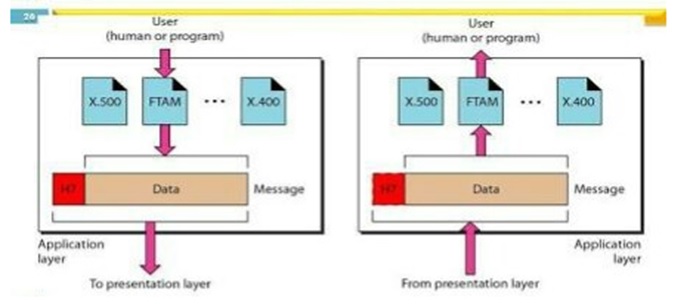Home »
Computer Network
Application Layer: What It Is, Design Issues, Functionalities, and Example
Description and Functions of Application Layer in the OSI model: In this tutorial, we are going to learn what the Application layer is and the Functions of Application Layer in the OSI model in Computer Networking. We will also discuss the Design Issues with Application Layer and the working of the Application Layer with the help of its diagram.
By Monika Jha Last updated : May 05, 2023
What is Application Layer?
The Application Layer is at the top level of the OSI model. It is permissible by this layer to the software or user to get access to the network.
- It provides interfaces and support for services such as electronic mail, remote file access, and transfer, shared database management, directory services, network resources, etc. and other types of distributed information services also.
- In numerous ways manipulation of data (information) is done in this layer.
- The Application Layer contains a variety of protocols that are commonly required by users. A widely-used application protocol is HTTP (HyperText Transfer Protocol), which is the basis for the World Wide Web(WWW).
- When a browser requests a web page, it sends the name of the page it wants to the server using HTTP. The server then fulfills the request by sending the page back.
- The application layer uses More than 15 protocols, including File Transfer Protocol, Telnet, Trivial File Transfer Protocol, and Simple Network Management Protocol, etc.
Example
Out of many available application services, the figure shows three services: X.400 (message-handling services);
- File transfer, access, and management (FTAM).
- The user in this example uses X.400 to send an e-mail message.
- There is no headers or trailers are added in this layer.
This figure shows the relationship of the Application layer to the user and the presentation layer.

Design Issues with Application Layer
In the design and implementation of Application Layer protocols occurring problems and these problems can be addressed by patterns from several different pattern languages:
- Design (pattern) Language for Application-level Communication Protocols
- Service Design Patterns
- Enterprise Application Architecture's Patterns
- Pattern-Oriented Software Architecture
Functionalities of the Application layer
Specific functionalities of the Application layer are as follows:
1. Network Virtual terminal
- The application layer is the software version of a physical terminal and this layer permitted to a user to log on to a remote host.
- For this, an application creates a software emulation of a terminal at the remote host. By this user's computer can communicate with the software terminal, which in turn, communicates with the host.
- It is shown that the remote host is communicating with one of its terminals, so it allows the user to log on.
2. File Transfer, Access, and Management (FTAM)
- An application permits a user to access files in a remote computer, to retrieve files from a computer and to manage files on a remote computer.
- FTAM is concerned with a hierarchical virtual file in terms of file attributes, file structure and the types of operations performed on the files and their attributes.
3. Addressing
- To achieve communication between client and server system, there is a need for addressing.
- When a request is sent from the client side to the server side, this request contains the server address and its own address.
- The server answered to the client request, this request contains the destination address, i.e., client address. DNS is used to achieve this type of addressing.
4. Mail Services
Email forwarding and storage of e-mails provided by an application layer.
5. Directory Services
A distributed database is contained by an application that provides access for global information about various objects and services.
6. Authentication
It provides authentication to occur between devices for an extra layer of security and it authenticates the sender or receiver's message or both.
Advertisement
Advertisement